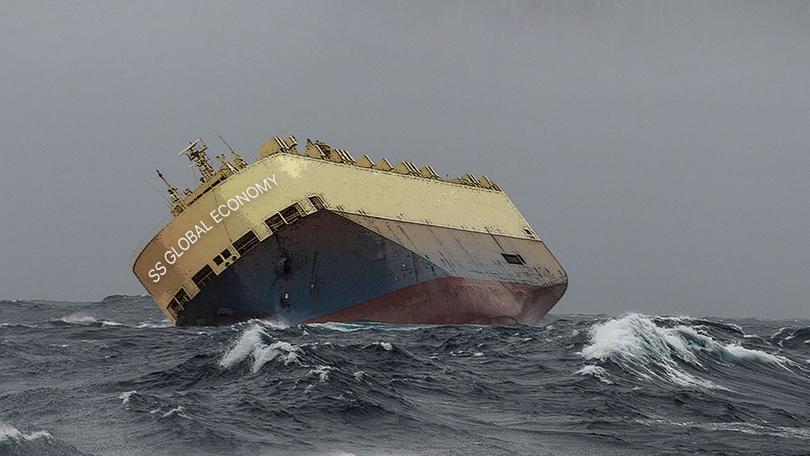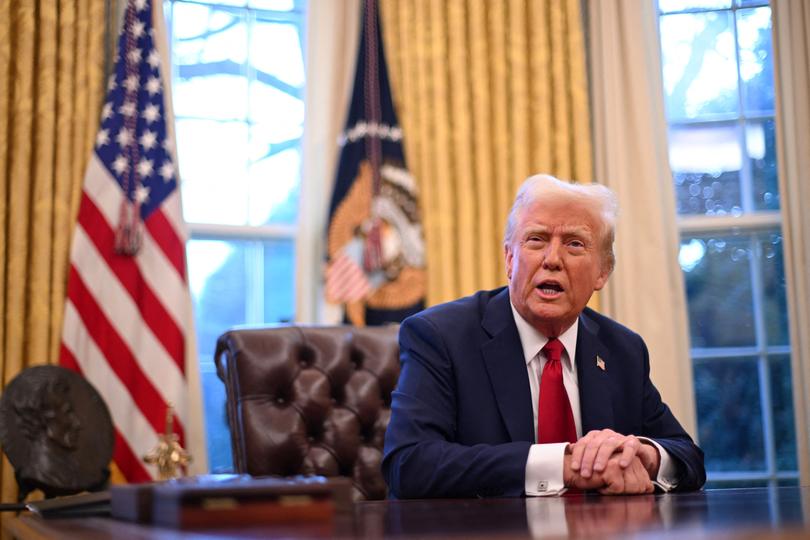JACKSON HEWETT: Four ways Donald Trump’s tariff tirade will hurt Australia

Donald Trump’s tariff madness is already causing widespread disruption, and despite the cautious optimism from the Federal Government that Australia may stay out of the firing line, the precedent has been set.
Get ready for serious instability in the global economy.
Mr Trump may be holding a gun to the head of his closest neighbours and trading partners to stop immigration and drugs, but he seems hellbent on exercising power over any country he can.
Sign up to The Nightly's newsletters.
Get the first look at the digital newspaper, curated daily stories and breaking headlines delivered to your inbox.
By continuing you agree to our Terms and Privacy Policy.A 25 per cent tariff on Canadian goods — excluding oil, which gets 10 per cent — and a 25 per cent tariff on Mexico is disastrous for those two trading partners, likely to smash their economies, wiping three per cent and two per cent off GDP, respectively.
Canada has already said it will fight back, threatening 25 per cent counter-tariffs on more than 1,200 imported US products. An additional 10 per cent tariff on Chinese goods will further tighten the screws on the world’s largest manufacturer.

Europe will likely also be hit, with Mr Trump telling reporters tariffs “will definitely happen with the European Union.” In response, the EU has said it will “respond firmly” to any US tariff.
Markets are in no doubt about the danger. Early trading on the Australian Stock Exchange saw 2 per cent wiped off its value, while U.S. stock futures plunged by a similar amount. The markets are responding to a situation where everything gets more expensive.
That means dumping risks for safe havens, fretting about the resilience of the consumer in the face of higher prices, and planning for higher interest rates, which will reduce company earnings.
Slower growth
Just as the world is starting to eke its way back to positive GDP growth after the pandemic, a Trump trade war would set it back. Australian economist Warwick McKibben estimates that a 25 per cent tariff on Mexico and Canada would wipe $US200b from the US economy during Mr Trump’s second term and $US100b from Canada’s. A 10 per cent additional tariff on China, followed by a reciprocal response, would take another $US55b from the US economy and $US128b from China’s over the Trump term.
Europe is a new addition to the tariff picture, and Mr McKibben found that the more countries caught up in US tariffs, the worse the impact on the US economy due to fewer opportunities for import substitutions.
Europe, Canada, Mexico, and China together account for 61 per cent of US imports, with Coolabah Capital’s Kieran Davies suggesting tariffs on those exporters would result in an effective tariff level not seen since the Great Depression.
Since a third of US spending is on goods, tariffs on imports could be inflationary, potentially adding up to 2 per cent to consumer prices. That would force the Federal Reserve to start hiking interest rates to reduce inflation, which in turn would slow the growth of the US economy and curtail one of the main drivers of the global economy.
Australian companies hit
The stock market saw a sell-off of companies with high exposure to the U.S. and global trade. Iron ore producers such as Fortescue and Champion Iron fell over 5 per cent on fears that China’s steel exports would take a hit. Rio Tinto and BHP followed suit, given their direct US exposure.
The US is a major market for Rio’s Canadian aluminium operations, while BHP is investing $US10.5b in a potash mine that would supply American farmers with fertiliser. Fisher & Paykel, a New Zealand company listed on the Australian Stock Exchange, warned that tariffs would raise costs and delay its forecast gross margin target by up to three years. Its Mexico-based manufacturing plant makes sleep apnea devices for the US market, which accounts for 43 per cent of group revenue.
The stock plunged nearly 8 per cent.
A suite of other companies with US exposure, including packaging, biomedical, and building supply firms, also fell. For investors in general, the frothy valuations of the US market have been a great money-spinner.
But with uncertainty across the economic spectrum, large-scale sell-offs are a very real possibility.
Kyle Rodda, senior financial market analyst at Capital.com, said tariffs are “bad for earnings, because it’s a squeeze on corporate margins and growth. It’s also bad for valuations because it increases volatility and lowers the odds of a rate cut from the Fed going forward.”
He expects companies that are tied to growth to perform badly, as well as export-driven firms.
One upside, however, may be for oil and gas stocks. With Canada hit with a 10 per cent tariff on energy, that may push up the price globally. “It’s not really manifesting today but that could be a sector that could benefit from the tariffs on Canada,” Mr Rodda said.
Agricultural exports are also at risk, according to Commonwealth Bank economist Dennis Voznesenski.
He expects a hit to the country’s $7b canola crop as Canadian producers are forced to find an alternative market. Beef producers, on the other hand, will gain. The US cattle herd is already at a 50-year low, and Canadian and Mexican beef is making up the shortfall. With tariffs applied, that could further boost Australian beef exports.
Search for safe havens
That volatility expected on stock markets has sent investors flying to the safe haven of gold. The yellow metal was already on a tear in 2024, soaring to a record high over concerns about the growing US deficit, and fears of rising U.S. inflation pushed it even higher today.
Gold has also been supported by widespread central bank buying, particularly in China. Having seen the impact of sanctions on Russia, the Chinese central bank has been a big accumulator of the precious metal, and markets would be expecting that to continue in the face of this aggressive tariff stance.
The US dollar also rose significantly on the expectation of higher US inflation, and as a result, higher interest rates, pushing the Australian dollar down by nearly 1 per cent to its lowest level in four years.
In times of crisis, the US dollar is seen as a safe haven asset, though when the US is the architect of risk, it will be interesting to see how investors view the dollar’s suitability.
Ironically, Bitcoin — often touted as an alternative store of value against U.S. debt instability — also fell. Bitcoin dropped more than 5 per cent on the tariff news, while nearest crypto rival Ethereum dropped as much as 25 per cent. “Some people will say that Bitcoin is a haven but it has never behaved that way,” Mr Rodda said. “It’s like a riskier version of U.S-tech in the short-term.”
Even Trump’s official memecoin wasn’t spared. From a high of $A121 in January, it has now fallen to $34, dropping as much as a fifth in value today.
Free trade cornerstone
While the Department of Foreign Affairs and Trade maintains that “Australia is a trading nation, and we will always continue to advocate for free and fair trade,” the danger is the impact of tit-for-tat tariffs. Under the previous Trump administration, Australia was hit with a series of punitive tariffs by China, including on barley, lobster, wine, and beef.
While there is no suggestion of further Chinese tariffs on Australia, Mr Voznesenski said the country’s agricultural sector has “thrived, and the reason it’s thrived has been exporting into international markets.”
By introducing tariffs arbitrarily, Mr Trump may jeopardise the global trading rules that have been central to Australia’s success. The uncertainty is also forcing other countries to increase self-sufficiency for fear of supply chain instability. “If you look at China, if you look at India, if you look at Egypt, these large importers have been increasing how much they can produce locally,” Mr Voznesenski said.
“In a world where our key markets are starting to produce more, that’s not a good thing, because our whole industry growth has been pegged on growing international demand.”

